Analyzing Human Factors' Influence on Healthcare Quality & Safety
VerifiedAdded on 2022/10/01
|11
|2855
|28
Essay
AI Summary
This essay critically analyzes the impact of human factors on healthcare quality and safety. It identifies factors such as uncoordinated care processes, fatigue, stress, poorly designed facilities, and fragmented medical systems as key influencers of work performance and patient outcomes. The essay reviews studies that evaluate human factors interventions and emphasizes the need for system-wide changes, including redesigning healthcare systems, simplifying medical procedures, utilizing checklists, and standardizing processes. It also highlights the importance of understanding human limitations and adopting practices from high-reliability industries to improve patient safety and overall quality of care. The goal is to empower healthcare professionals to prioritize clinical excellence and mitigate potential harm to patients through a comprehensive approach to human factors in healthcare.
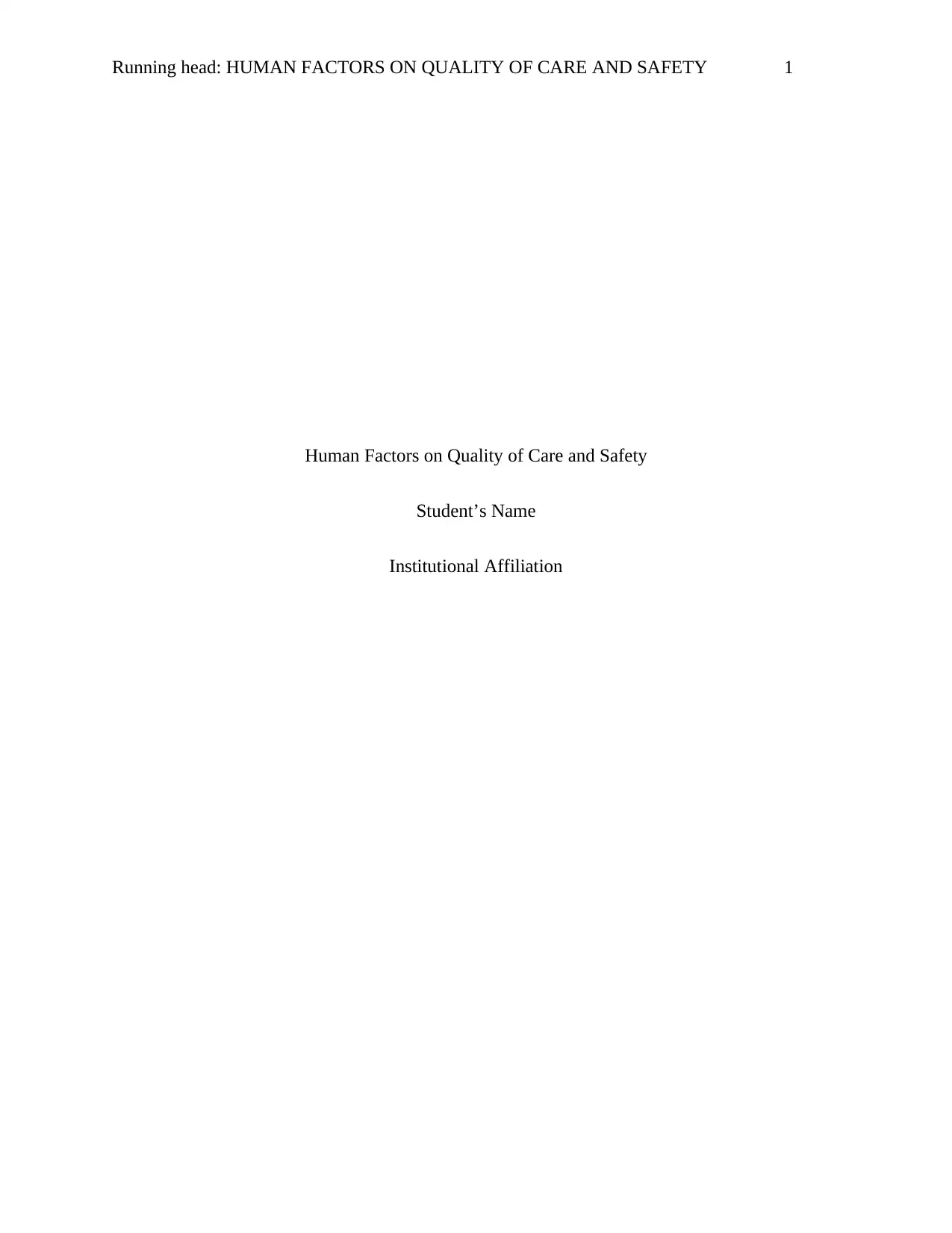
Running head: HUMAN FACTORS ON QUALITY OF CARE AND SAFETY 1
Human Factors on Quality of Care and Safety
Student’s Name
Institutional Affiliation
Human Factors on Quality of Care and Safety
Student’s Name
Institutional Affiliation
Paraphrase This Document
Need a fresh take? Get an instant paraphrase of this document with our AI Paraphraser
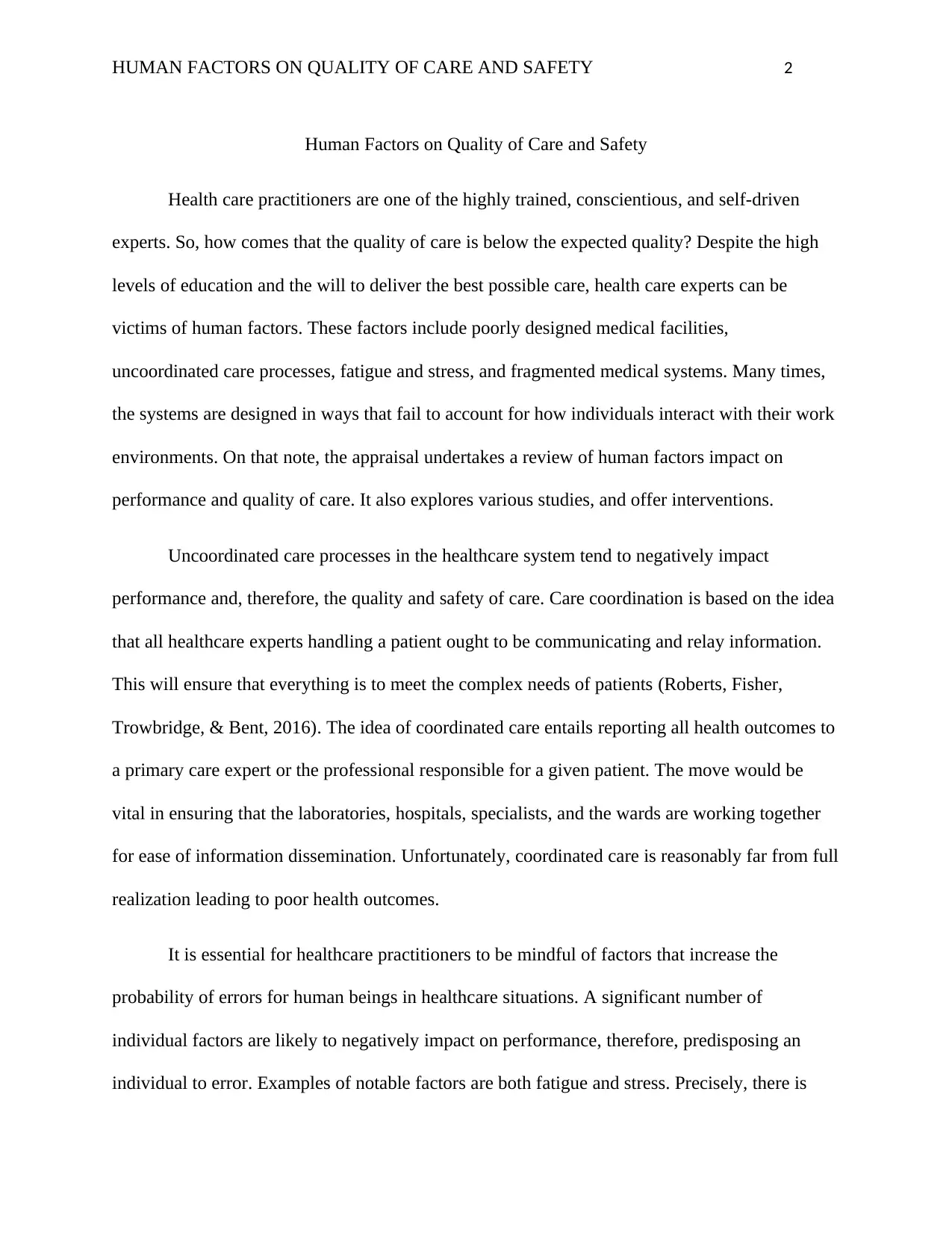
HUMAN FACTORS ON QUALITY OF CARE AND SAFETY 2
Human Factors on Quality of Care and Safety
Health care practitioners are one of the highly trained, conscientious, and self-driven
experts. So, how comes that the quality of care is below the expected quality? Despite the high
levels of education and the will to deliver the best possible care, health care experts can be
victims of human factors. These factors include poorly designed medical facilities,
uncoordinated care processes, fatigue and stress, and fragmented medical systems. Many times,
the systems are designed in ways that fail to account for how individuals interact with their work
environments. On that note, the appraisal undertakes a review of human factors impact on
performance and quality of care. It also explores various studies, and offer interventions.
Uncoordinated care processes in the healthcare system tend to negatively impact
performance and, therefore, the quality and safety of care. Care coordination is based on the idea
that all healthcare experts handling a patient ought to be communicating and relay information.
This will ensure that everything is to meet the complex needs of patients (Roberts, Fisher,
Trowbridge, & Bent, 2016). The idea of coordinated care entails reporting all health outcomes to
a primary care expert or the professional responsible for a given patient. The move would be
vital in ensuring that the laboratories, hospitals, specialists, and the wards are working together
for ease of information dissemination. Unfortunately, coordinated care is reasonably far from full
realization leading to poor health outcomes.
It is essential for healthcare practitioners to be mindful of factors that increase the
probability of errors for human beings in healthcare situations. A significant number of
individual factors are likely to negatively impact on performance, therefore, predisposing an
individual to error. Examples of notable factors are both fatigue and stress. Precisely, there is
Human Factors on Quality of Care and Safety
Health care practitioners are one of the highly trained, conscientious, and self-driven
experts. So, how comes that the quality of care is below the expected quality? Despite the high
levels of education and the will to deliver the best possible care, health care experts can be
victims of human factors. These factors include poorly designed medical facilities,
uncoordinated care processes, fatigue and stress, and fragmented medical systems. Many times,
the systems are designed in ways that fail to account for how individuals interact with their work
environments. On that note, the appraisal undertakes a review of human factors impact on
performance and quality of care. It also explores various studies, and offer interventions.
Uncoordinated care processes in the healthcare system tend to negatively impact
performance and, therefore, the quality and safety of care. Care coordination is based on the idea
that all healthcare experts handling a patient ought to be communicating and relay information.
This will ensure that everything is to meet the complex needs of patients (Roberts, Fisher,
Trowbridge, & Bent, 2016). The idea of coordinated care entails reporting all health outcomes to
a primary care expert or the professional responsible for a given patient. The move would be
vital in ensuring that the laboratories, hospitals, specialists, and the wards are working together
for ease of information dissemination. Unfortunately, coordinated care is reasonably far from full
realization leading to poor health outcomes.
It is essential for healthcare practitioners to be mindful of factors that increase the
probability of errors for human beings in healthcare situations. A significant number of
individual factors are likely to negatively impact on performance, therefore, predisposing an
individual to error. Examples of notable factors are both fatigue and stress. Precisely, there is
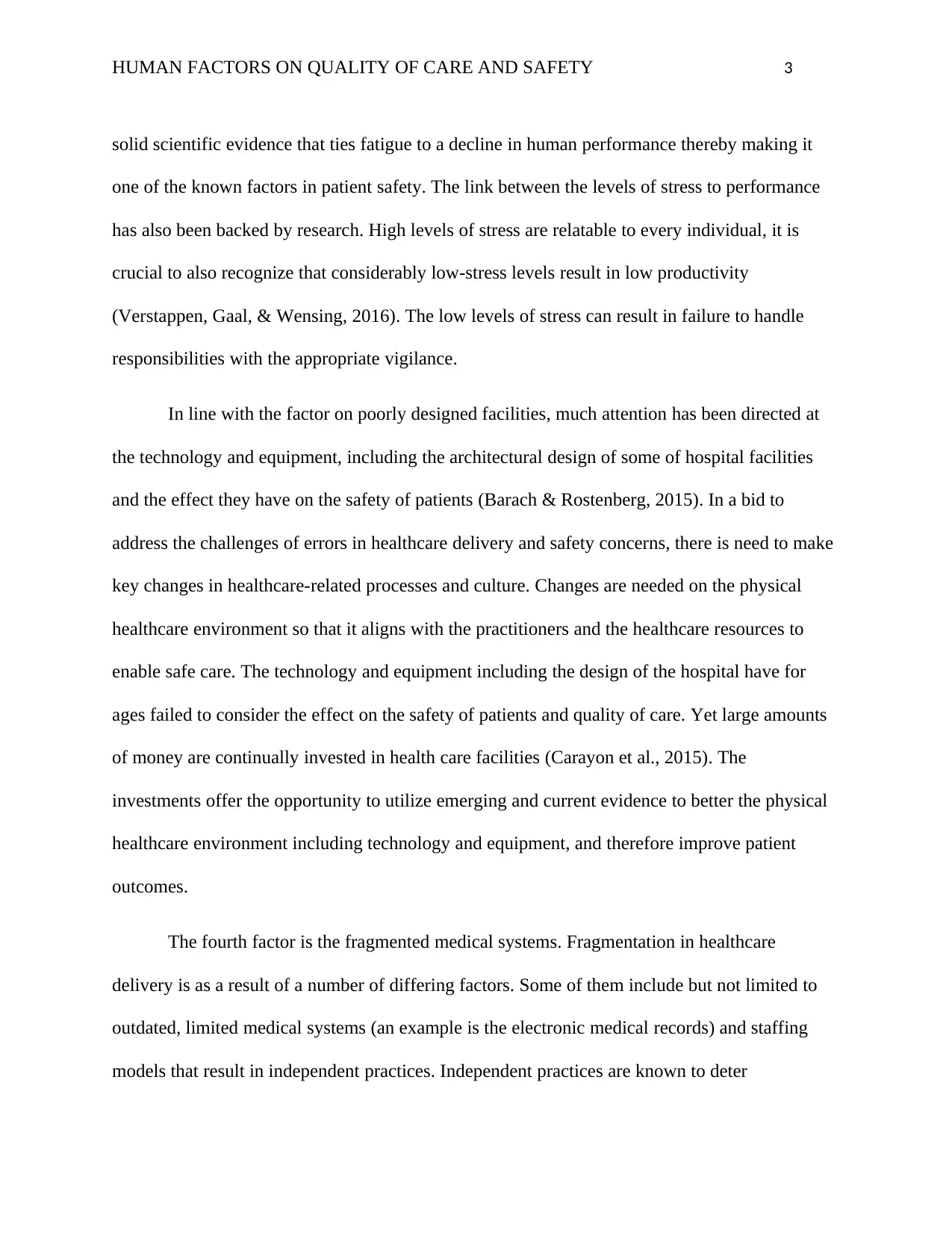
HUMAN FACTORS ON QUALITY OF CARE AND SAFETY 3
solid scientific evidence that ties fatigue to a decline in human performance thereby making it
one of the known factors in patient safety. The link between the levels of stress to performance
has also been backed by research. High levels of stress are relatable to every individual, it is
crucial to also recognize that considerably low-stress levels result in low productivity
(Verstappen, Gaal, & Wensing, 2016). The low levels of stress can result in failure to handle
responsibilities with the appropriate vigilance.
In line with the factor on poorly designed facilities, much attention has been directed at
the technology and equipment, including the architectural design of some of hospital facilities
and the effect they have on the safety of patients (Barach & Rostenberg, 2015). In a bid to
address the challenges of errors in healthcare delivery and safety concerns, there is need to make
key changes in healthcare-related processes and culture. Changes are needed on the physical
healthcare environment so that it aligns with the practitioners and the healthcare resources to
enable safe care. The technology and equipment including the design of the hospital have for
ages failed to consider the effect on the safety of patients and quality of care. Yet large amounts
of money are continually invested in health care facilities (Carayon et al., 2015). The
investments offer the opportunity to utilize emerging and current evidence to better the physical
healthcare environment including technology and equipment, and therefore improve patient
outcomes.
The fourth factor is the fragmented medical systems. Fragmentation in healthcare
delivery is as a result of a number of differing factors. Some of them include but not limited to
outdated, limited medical systems (an example is the electronic medical records) and staffing
models that result in independent practices. Independent practices are known to deter
solid scientific evidence that ties fatigue to a decline in human performance thereby making it
one of the known factors in patient safety. The link between the levels of stress to performance
has also been backed by research. High levels of stress are relatable to every individual, it is
crucial to also recognize that considerably low-stress levels result in low productivity
(Verstappen, Gaal, & Wensing, 2016). The low levels of stress can result in failure to handle
responsibilities with the appropriate vigilance.
In line with the factor on poorly designed facilities, much attention has been directed at
the technology and equipment, including the architectural design of some of hospital facilities
and the effect they have on the safety of patients (Barach & Rostenberg, 2015). In a bid to
address the challenges of errors in healthcare delivery and safety concerns, there is need to make
key changes in healthcare-related processes and culture. Changes are needed on the physical
healthcare environment so that it aligns with the practitioners and the healthcare resources to
enable safe care. The technology and equipment including the design of the hospital have for
ages failed to consider the effect on the safety of patients and quality of care. Yet large amounts
of money are continually invested in health care facilities (Carayon et al., 2015). The
investments offer the opportunity to utilize emerging and current evidence to better the physical
healthcare environment including technology and equipment, and therefore improve patient
outcomes.
The fourth factor is the fragmented medical systems. Fragmentation in healthcare
delivery is as a result of a number of differing factors. Some of them include but not limited to
outdated, limited medical systems (an example is the electronic medical records) and staffing
models that result in independent practices. Independent practices are known to deter
⊘ This is a preview!⊘
Do you want full access?
Subscribe today to unlock all pages.

Trusted by 1+ million students worldwide
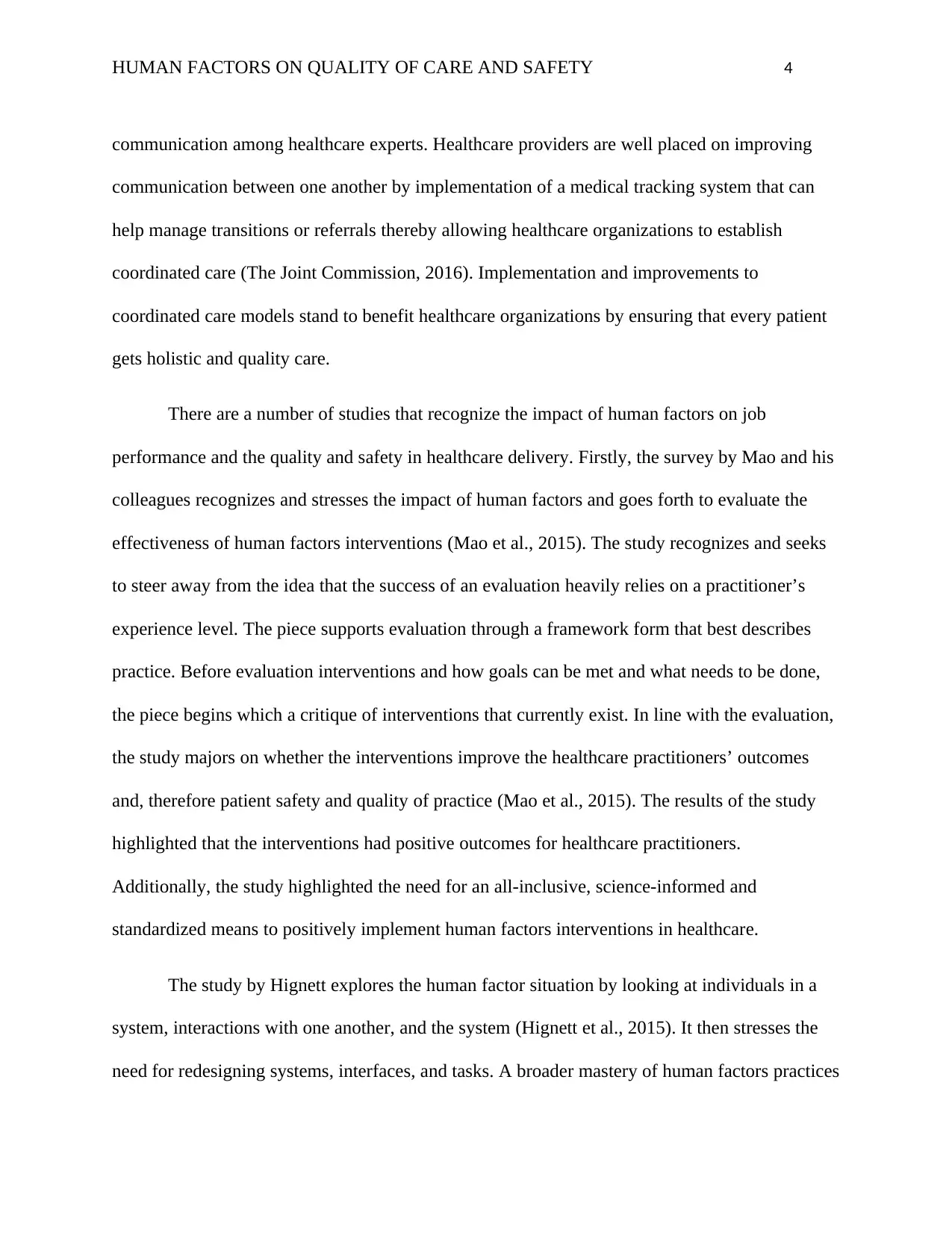
HUMAN FACTORS ON QUALITY OF CARE AND SAFETY 4
communication among healthcare experts. Healthcare providers are well placed on improving
communication between one another by implementation of a medical tracking system that can
help manage transitions or referrals thereby allowing healthcare organizations to establish
coordinated care (The Joint Commission, 2016). Implementation and improvements to
coordinated care models stand to benefit healthcare organizations by ensuring that every patient
gets holistic and quality care.
There are a number of studies that recognize the impact of human factors on job
performance and the quality and safety in healthcare delivery. Firstly, the survey by Mao and his
colleagues recognizes and stresses the impact of human factors and goes forth to evaluate the
effectiveness of human factors interventions (Mao et al., 2015). The study recognizes and seeks
to steer away from the idea that the success of an evaluation heavily relies on a practitioner’s
experience level. The piece supports evaluation through a framework form that best describes
practice. Before evaluation interventions and how goals can be met and what needs to be done,
the piece begins which a critique of interventions that currently exist. In line with the evaluation,
the study majors on whether the interventions improve the healthcare practitioners’ outcomes
and, therefore patient safety and quality of practice (Mao et al., 2015). The results of the study
highlighted that the interventions had positive outcomes for healthcare practitioners.
Additionally, the study highlighted the need for an all-inclusive, science-informed and
standardized means to positively implement human factors interventions in healthcare.
The study by Hignett explores the human factor situation by looking at individuals in a
system, interactions with one another, and the system (Hignett et al., 2015). It then stresses the
need for redesigning systems, interfaces, and tasks. A broader mastery of human factors practices
communication among healthcare experts. Healthcare providers are well placed on improving
communication between one another by implementation of a medical tracking system that can
help manage transitions or referrals thereby allowing healthcare organizations to establish
coordinated care (The Joint Commission, 2016). Implementation and improvements to
coordinated care models stand to benefit healthcare organizations by ensuring that every patient
gets holistic and quality care.
There are a number of studies that recognize the impact of human factors on job
performance and the quality and safety in healthcare delivery. Firstly, the survey by Mao and his
colleagues recognizes and stresses the impact of human factors and goes forth to evaluate the
effectiveness of human factors interventions (Mao et al., 2015). The study recognizes and seeks
to steer away from the idea that the success of an evaluation heavily relies on a practitioner’s
experience level. The piece supports evaluation through a framework form that best describes
practice. Before evaluation interventions and how goals can be met and what needs to be done,
the piece begins which a critique of interventions that currently exist. In line with the evaluation,
the study majors on whether the interventions improve the healthcare practitioners’ outcomes
and, therefore patient safety and quality of practice (Mao et al., 2015). The results of the study
highlighted that the interventions had positive outcomes for healthcare practitioners.
Additionally, the study highlighted the need for an all-inclusive, science-informed and
standardized means to positively implement human factors interventions in healthcare.
The study by Hignett explores the human factor situation by looking at individuals in a
system, interactions with one another, and the system (Hignett et al., 2015). It then stresses the
need for redesigning systems, interfaces, and tasks. A broader mastery of human factors practices
Paraphrase This Document
Need a fresh take? Get an instant paraphrase of this document with our AI Paraphraser
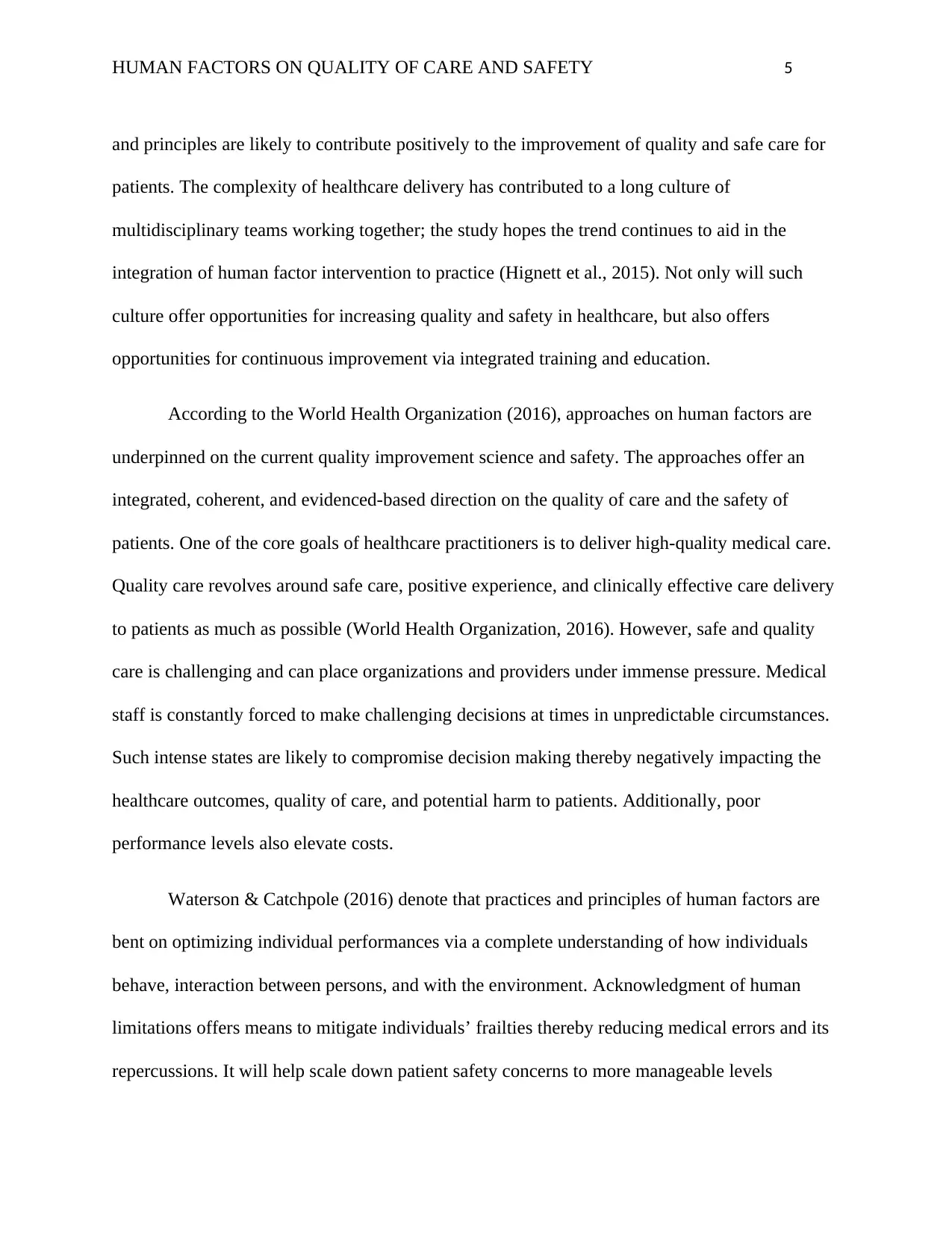
HUMAN FACTORS ON QUALITY OF CARE AND SAFETY 5
and principles are likely to contribute positively to the improvement of quality and safe care for
patients. The complexity of healthcare delivery has contributed to a long culture of
multidisciplinary teams working together; the study hopes the trend continues to aid in the
integration of human factor intervention to practice (Hignett et al., 2015). Not only will such
culture offer opportunities for increasing quality and safety in healthcare, but also offers
opportunities for continuous improvement via integrated training and education.
According to the World Health Organization (2016), approaches on human factors are
underpinned on the current quality improvement science and safety. The approaches offer an
integrated, coherent, and evidenced-based direction on the quality of care and the safety of
patients. One of the core goals of healthcare practitioners is to deliver high-quality medical care.
Quality care revolves around safe care, positive experience, and clinically effective care delivery
to patients as much as possible (World Health Organization, 2016). However, safe and quality
care is challenging and can place organizations and providers under immense pressure. Medical
staff is constantly forced to make challenging decisions at times in unpredictable circumstances.
Such intense states are likely to compromise decision making thereby negatively impacting the
healthcare outcomes, quality of care, and potential harm to patients. Additionally, poor
performance levels also elevate costs.
Waterson & Catchpole (2016) denote that practices and principles of human factors are
bent on optimizing individual performances via a complete understanding of how individuals
behave, interaction between persons, and with the environment. Acknowledgment of human
limitations offers means to mitigate individuals’ frailties thereby reducing medical errors and its
repercussions. It will help scale down patient safety concerns to more manageable levels
and principles are likely to contribute positively to the improvement of quality and safe care for
patients. The complexity of healthcare delivery has contributed to a long culture of
multidisciplinary teams working together; the study hopes the trend continues to aid in the
integration of human factor intervention to practice (Hignett et al., 2015). Not only will such
culture offer opportunities for increasing quality and safety in healthcare, but also offers
opportunities for continuous improvement via integrated training and education.
According to the World Health Organization (2016), approaches on human factors are
underpinned on the current quality improvement science and safety. The approaches offer an
integrated, coherent, and evidenced-based direction on the quality of care and the safety of
patients. One of the core goals of healthcare practitioners is to deliver high-quality medical care.
Quality care revolves around safe care, positive experience, and clinically effective care delivery
to patients as much as possible (World Health Organization, 2016). However, safe and quality
care is challenging and can place organizations and providers under immense pressure. Medical
staff is constantly forced to make challenging decisions at times in unpredictable circumstances.
Such intense states are likely to compromise decision making thereby negatively impacting the
healthcare outcomes, quality of care, and potential harm to patients. Additionally, poor
performance levels also elevate costs.
Waterson & Catchpole (2016) denote that practices and principles of human factors are
bent on optimizing individual performances via a complete understanding of how individuals
behave, interaction between persons, and with the environment. Acknowledgment of human
limitations offers means to mitigate individuals’ frailties thereby reducing medical errors and its
repercussions. It will help scale down patient safety concerns to more manageable levels
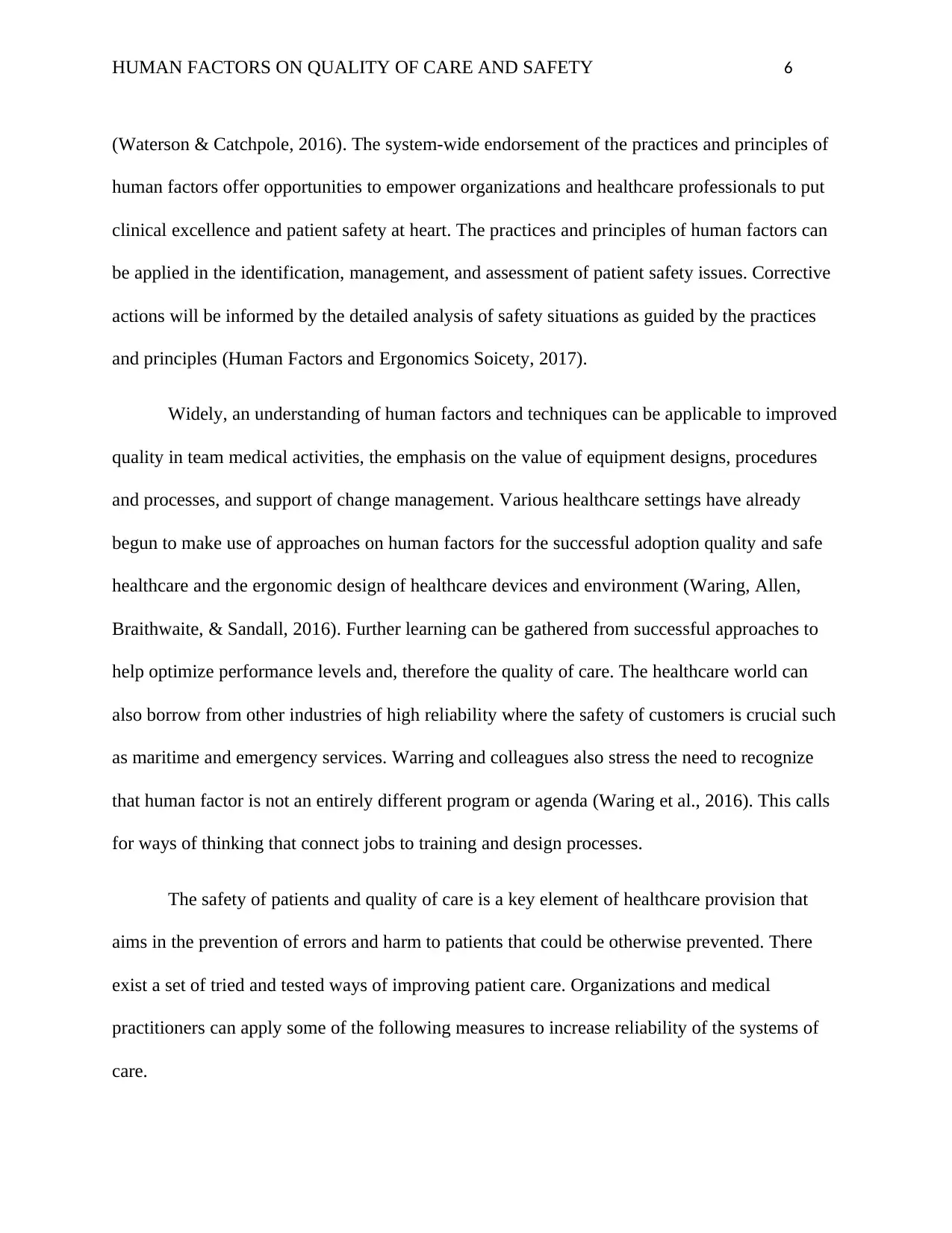
HUMAN FACTORS ON QUALITY OF CARE AND SAFETY 6
(Waterson & Catchpole, 2016). The system-wide endorsement of the practices and principles of
human factors offer opportunities to empower organizations and healthcare professionals to put
clinical excellence and patient safety at heart. The practices and principles of human factors can
be applied in the identification, management, and assessment of patient safety issues. Corrective
actions will be informed by the detailed analysis of safety situations as guided by the practices
and principles (Human Factors and Ergonomics Soicety, 2017).
Widely, an understanding of human factors and techniques can be applicable to improved
quality in team medical activities, the emphasis on the value of equipment designs, procedures
and processes, and support of change management. Various healthcare settings have already
begun to make use of approaches on human factors for the successful adoption quality and safe
healthcare and the ergonomic design of healthcare devices and environment (Waring, Allen,
Braithwaite, & Sandall, 2016). Further learning can be gathered from successful approaches to
help optimize performance levels and, therefore the quality of care. The healthcare world can
also borrow from other industries of high reliability where the safety of customers is crucial such
as maritime and emergency services. Warring and colleagues also stress the need to recognize
that human factor is not an entirely different program or agenda (Waring et al., 2016). This calls
for ways of thinking that connect jobs to training and design processes.
The safety of patients and quality of care is a key element of healthcare provision that
aims in the prevention of errors and harm to patients that could be otherwise prevented. There
exist a set of tried and tested ways of improving patient care. Organizations and medical
practitioners can apply some of the following measures to increase reliability of the systems of
care.
(Waterson & Catchpole, 2016). The system-wide endorsement of the practices and principles of
human factors offer opportunities to empower organizations and healthcare professionals to put
clinical excellence and patient safety at heart. The practices and principles of human factors can
be applied in the identification, management, and assessment of patient safety issues. Corrective
actions will be informed by the detailed analysis of safety situations as guided by the practices
and principles (Human Factors and Ergonomics Soicety, 2017).
Widely, an understanding of human factors and techniques can be applicable to improved
quality in team medical activities, the emphasis on the value of equipment designs, procedures
and processes, and support of change management. Various healthcare settings have already
begun to make use of approaches on human factors for the successful adoption quality and safe
healthcare and the ergonomic design of healthcare devices and environment (Waring, Allen,
Braithwaite, & Sandall, 2016). Further learning can be gathered from successful approaches to
help optimize performance levels and, therefore the quality of care. The healthcare world can
also borrow from other industries of high reliability where the safety of customers is crucial such
as maritime and emergency services. Warring and colleagues also stress the need to recognize
that human factor is not an entirely different program or agenda (Waring et al., 2016). This calls
for ways of thinking that connect jobs to training and design processes.
The safety of patients and quality of care is a key element of healthcare provision that
aims in the prevention of errors and harm to patients that could be otherwise prevented. There
exist a set of tried and tested ways of improving patient care. Organizations and medical
practitioners can apply some of the following measures to increase reliability of the systems of
care.
⊘ This is a preview!⊘
Do you want full access?
Subscribe today to unlock all pages.

Trusted by 1+ million students worldwide
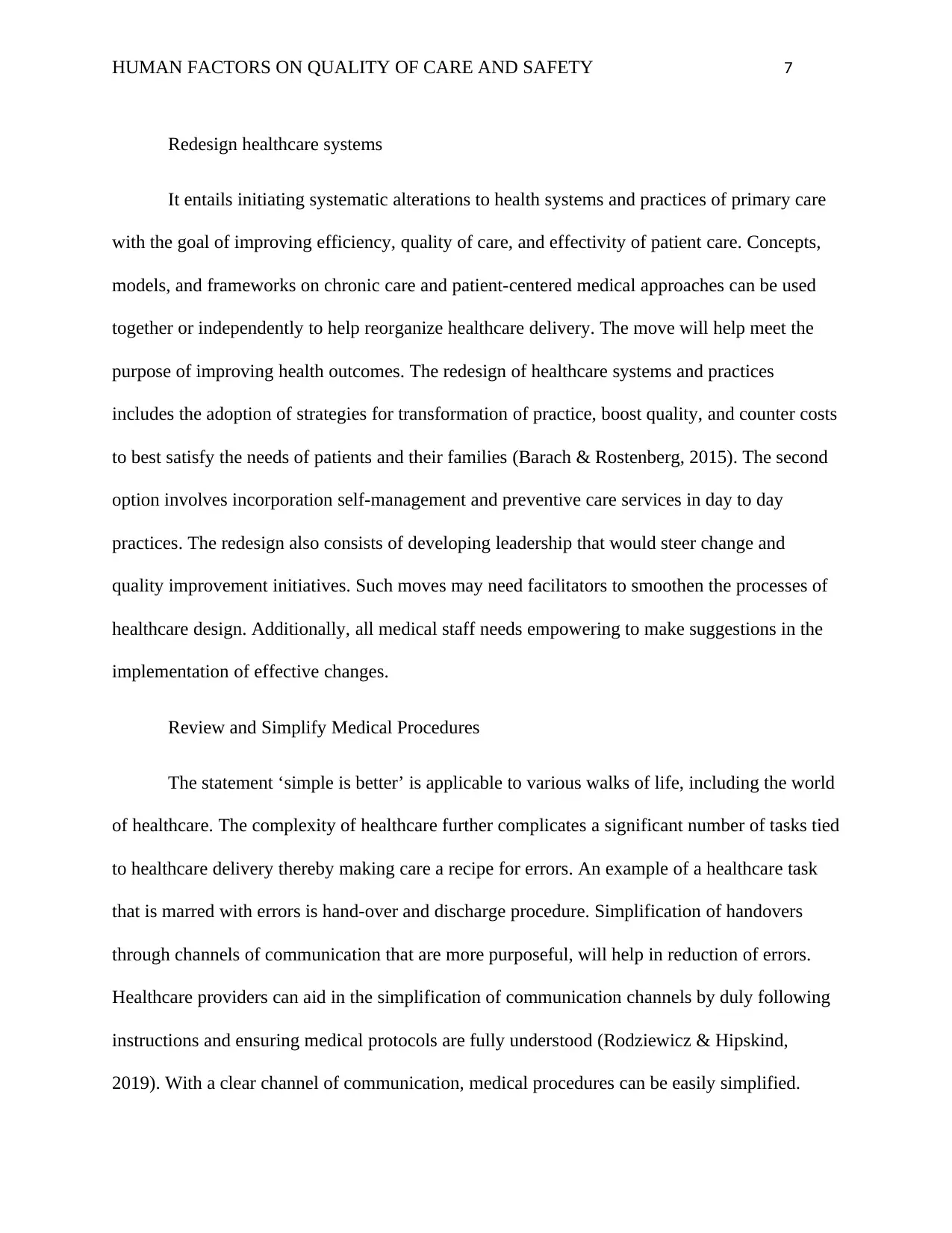
HUMAN FACTORS ON QUALITY OF CARE AND SAFETY 7
Redesign healthcare systems
It entails initiating systematic alterations to health systems and practices of primary care
with the goal of improving efficiency, quality of care, and effectivity of patient care. Concepts,
models, and frameworks on chronic care and patient-centered medical approaches can be used
together or independently to help reorganize healthcare delivery. The move will help meet the
purpose of improving health outcomes. The redesign of healthcare systems and practices
includes the adoption of strategies for transformation of practice, boost quality, and counter costs
to best satisfy the needs of patients and their families (Barach & Rostenberg, 2015). The second
option involves incorporation self-management and preventive care services in day to day
practices. The redesign also consists of developing leadership that would steer change and
quality improvement initiatives. Such moves may need facilitators to smoothen the processes of
healthcare design. Additionally, all medical staff needs empowering to make suggestions in the
implementation of effective changes.
Review and Simplify Medical Procedures
The statement ‘simple is better’ is applicable to various walks of life, including the world
of healthcare. The complexity of healthcare further complicates a significant number of tasks tied
to healthcare delivery thereby making care a recipe for errors. An example of a healthcare task
that is marred with errors is hand-over and discharge procedure. Simplification of handovers
through channels of communication that are more purposeful, will help in reduction of errors.
Healthcare providers can aid in the simplification of communication channels by duly following
instructions and ensuring medical protocols are fully understood (Rodziewicz & Hipskind,
2019). With a clear channel of communication, medical procedures can be easily simplified.
Redesign healthcare systems
It entails initiating systematic alterations to health systems and practices of primary care
with the goal of improving efficiency, quality of care, and effectivity of patient care. Concepts,
models, and frameworks on chronic care and patient-centered medical approaches can be used
together or independently to help reorganize healthcare delivery. The move will help meet the
purpose of improving health outcomes. The redesign of healthcare systems and practices
includes the adoption of strategies for transformation of practice, boost quality, and counter costs
to best satisfy the needs of patients and their families (Barach & Rostenberg, 2015). The second
option involves incorporation self-management and preventive care services in day to day
practices. The redesign also consists of developing leadership that would steer change and
quality improvement initiatives. Such moves may need facilitators to smoothen the processes of
healthcare design. Additionally, all medical staff needs empowering to make suggestions in the
implementation of effective changes.
Review and Simplify Medical Procedures
The statement ‘simple is better’ is applicable to various walks of life, including the world
of healthcare. The complexity of healthcare further complicates a significant number of tasks tied
to healthcare delivery thereby making care a recipe for errors. An example of a healthcare task
that is marred with errors is hand-over and discharge procedure. Simplification of handovers
through channels of communication that are more purposeful, will help in reduction of errors.
Healthcare providers can aid in the simplification of communication channels by duly following
instructions and ensuring medical protocols are fully understood (Rodziewicz & Hipskind,
2019). With a clear channel of communication, medical procedures can be easily simplified.
Paraphrase This Document
Need a fresh take? Get an instant paraphrase of this document with our AI Paraphraser
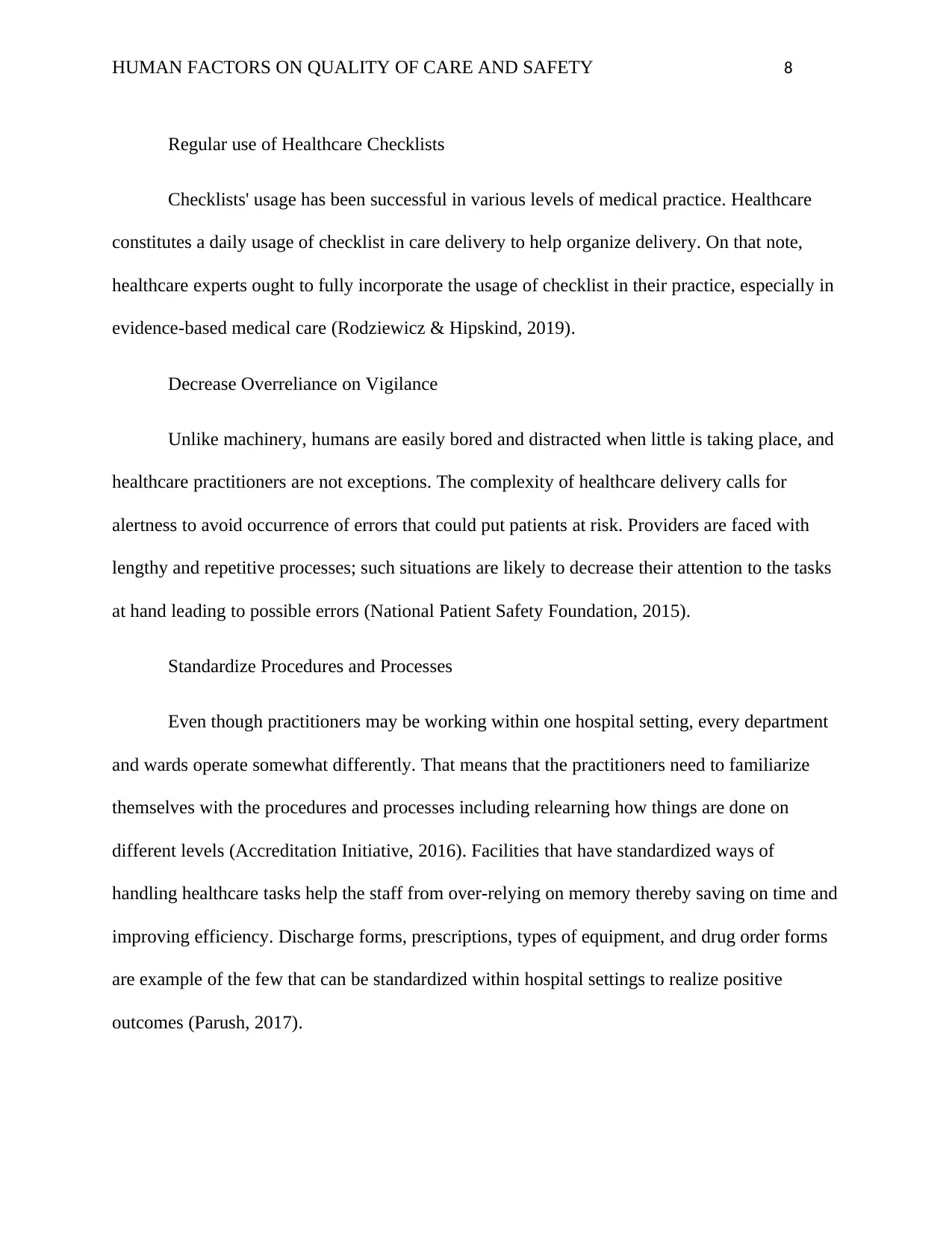
HUMAN FACTORS ON QUALITY OF CARE AND SAFETY 8
Regular use of Healthcare Checklists
Checklists' usage has been successful in various levels of medical practice. Healthcare
constitutes a daily usage of checklist in care delivery to help organize delivery. On that note,
healthcare experts ought to fully incorporate the usage of checklist in their practice, especially in
evidence-based medical care (Rodziewicz & Hipskind, 2019).
Decrease Overreliance on Vigilance
Unlike machinery, humans are easily bored and distracted when little is taking place, and
healthcare practitioners are not exceptions. The complexity of healthcare delivery calls for
alertness to avoid occurrence of errors that could put patients at risk. Providers are faced with
lengthy and repetitive processes; such situations are likely to decrease their attention to the tasks
at hand leading to possible errors (National Patient Safety Foundation, 2015).
Standardize Procedures and Processes
Even though practitioners may be working within one hospital setting, every department
and wards operate somewhat differently. That means that the practitioners need to familiarize
themselves with the procedures and processes including relearning how things are done on
different levels (Accreditation Initiative, 2016). Facilities that have standardized ways of
handling healthcare tasks help the staff from over-relying on memory thereby saving on time and
improving efficiency. Discharge forms, prescriptions, types of equipment, and drug order forms
are example of the few that can be standardized within hospital settings to realize positive
outcomes (Parush, 2017).
Regular use of Healthcare Checklists
Checklists' usage has been successful in various levels of medical practice. Healthcare
constitutes a daily usage of checklist in care delivery to help organize delivery. On that note,
healthcare experts ought to fully incorporate the usage of checklist in their practice, especially in
evidence-based medical care (Rodziewicz & Hipskind, 2019).
Decrease Overreliance on Vigilance
Unlike machinery, humans are easily bored and distracted when little is taking place, and
healthcare practitioners are not exceptions. The complexity of healthcare delivery calls for
alertness to avoid occurrence of errors that could put patients at risk. Providers are faced with
lengthy and repetitive processes; such situations are likely to decrease their attention to the tasks
at hand leading to possible errors (National Patient Safety Foundation, 2015).
Standardize Procedures and Processes
Even though practitioners may be working within one hospital setting, every department
and wards operate somewhat differently. That means that the practitioners need to familiarize
themselves with the procedures and processes including relearning how things are done on
different levels (Accreditation Initiative, 2016). Facilities that have standardized ways of
handling healthcare tasks help the staff from over-relying on memory thereby saving on time and
improving efficiency. Discharge forms, prescriptions, types of equipment, and drug order forms
are example of the few that can be standardized within hospital settings to realize positive
outcomes (Parush, 2017).
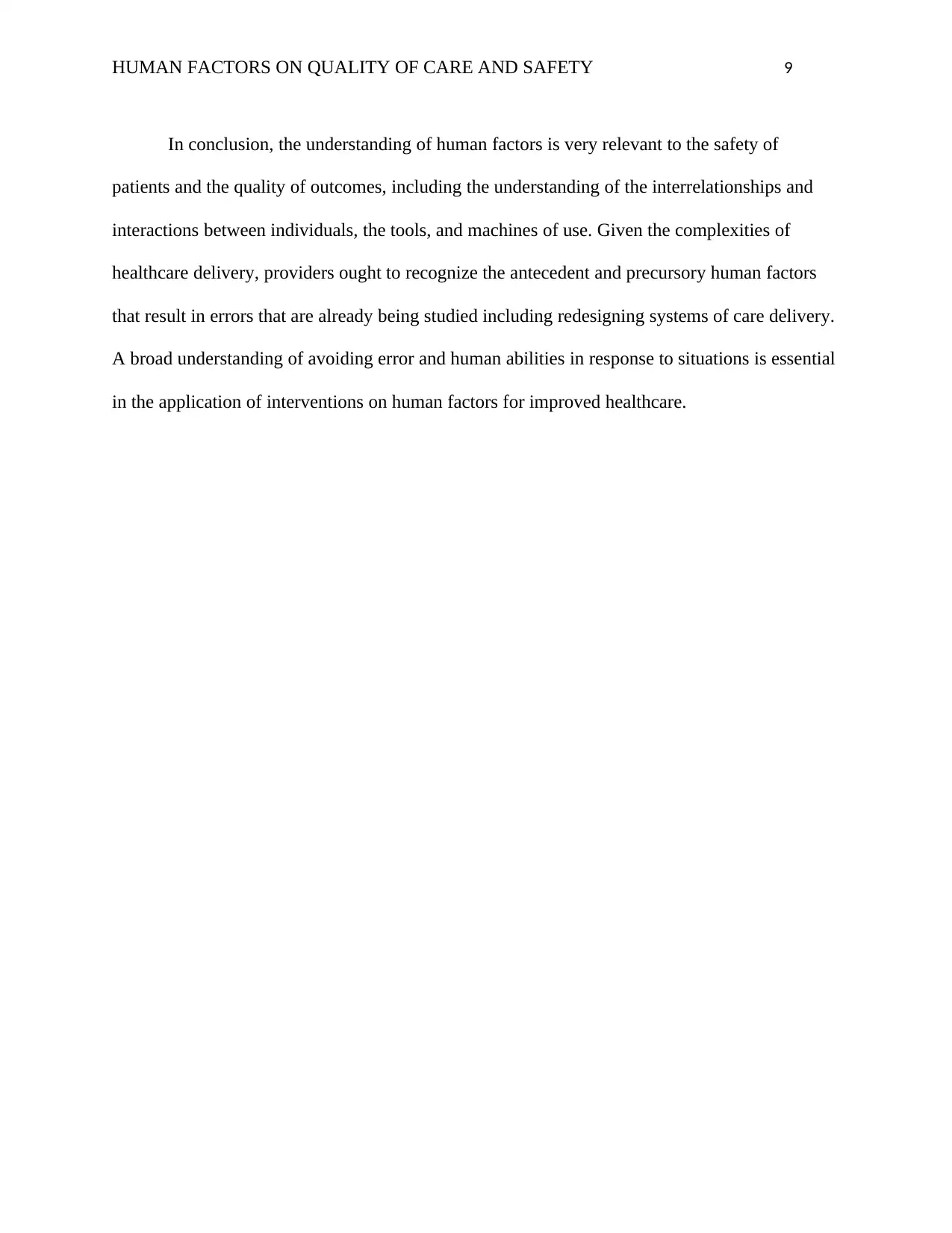
HUMAN FACTORS ON QUALITY OF CARE AND SAFETY 9
In conclusion, the understanding of human factors is very relevant to the safety of
patients and the quality of outcomes, including the understanding of the interrelationships and
interactions between individuals, the tools, and machines of use. Given the complexities of
healthcare delivery, providers ought to recognize the antecedent and precursory human factors
that result in errors that are already being studied including redesigning systems of care delivery.
A broad understanding of avoiding error and human abilities in response to situations is essential
in the application of interventions on human factors for improved healthcare.
In conclusion, the understanding of human factors is very relevant to the safety of
patients and the quality of outcomes, including the understanding of the interrelationships and
interactions between individuals, the tools, and machines of use. Given the complexities of
healthcare delivery, providers ought to recognize the antecedent and precursory human factors
that result in errors that are already being studied including redesigning systems of care delivery.
A broad understanding of avoiding error and human abilities in response to situations is essential
in the application of interventions on human factors for improved healthcare.
⊘ This is a preview!⊘
Do you want full access?
Subscribe today to unlock all pages.

Trusted by 1+ million students worldwide
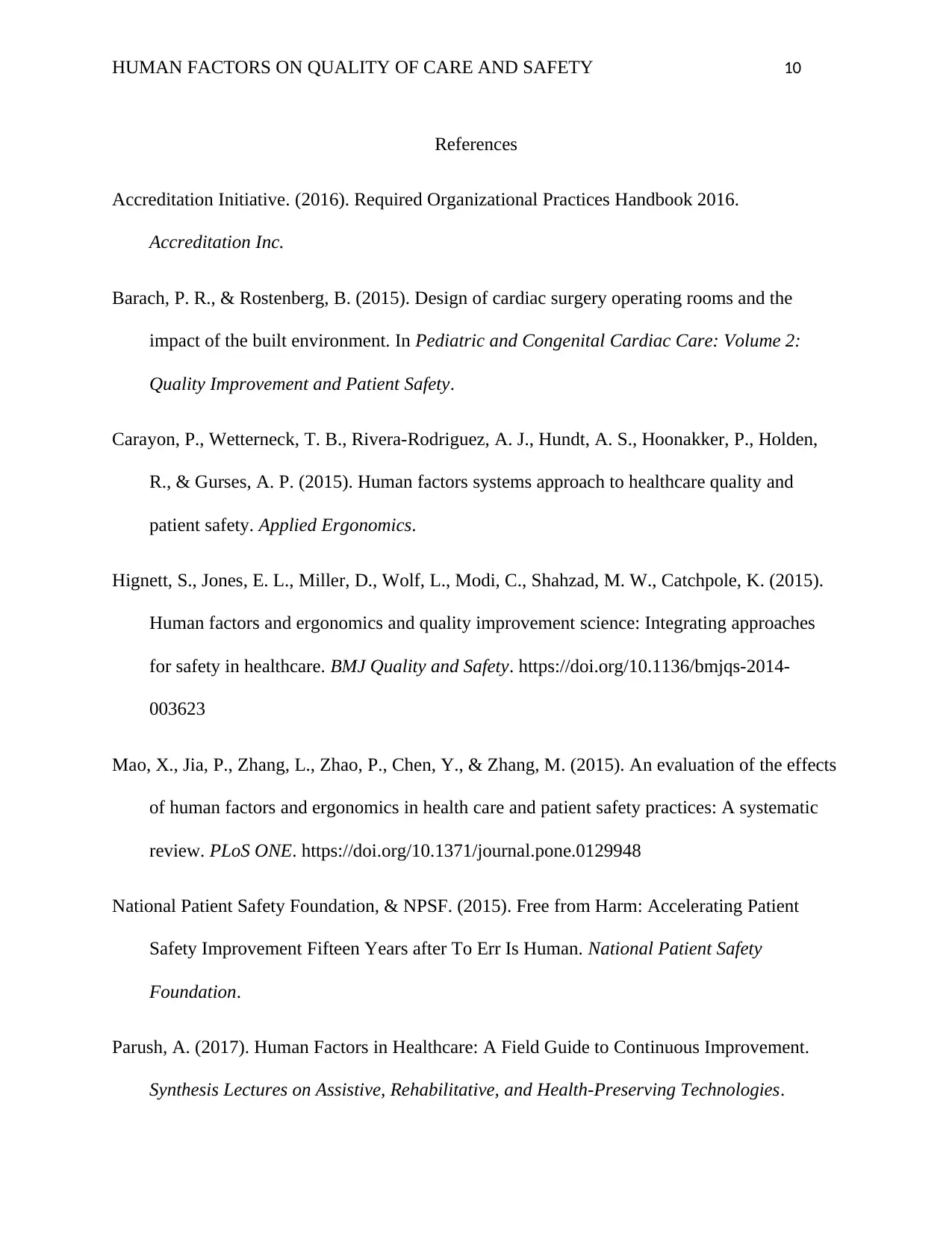
HUMAN FACTORS ON QUALITY OF CARE AND SAFETY 10
References
Accreditation Initiative. (2016). Required Organizational Practices Handbook 2016.
Accreditation Inc.
Barach, P. R., & Rostenberg, B. (2015). Design of cardiac surgery operating rooms and the
impact of the built environment. In Pediatric and Congenital Cardiac Care: Volume 2:
Quality Improvement and Patient Safety.
Carayon, P., Wetterneck, T. B., Rivera-Rodriguez, A. J., Hundt, A. S., Hoonakker, P., Holden,
R., & Gurses, A. P. (2015). Human factors systems approach to healthcare quality and
patient safety. Applied Ergonomics.
Hignett, S., Jones, E. L., Miller, D., Wolf, L., Modi, C., Shahzad, M. W., Catchpole, K. (2015).
Human factors and ergonomics and quality improvement science: Integrating approaches
for safety in healthcare. BMJ Quality and Safety. https://doi.org/10.1136/bmjqs-2014-
003623
Mao, X., Jia, P., Zhang, L., Zhao, P., Chen, Y., & Zhang, M. (2015). An evaluation of the effects
of human factors and ergonomics in health care and patient safety practices: A systematic
review. PLoS ONE. https://doi.org/10.1371/journal.pone.0129948
National Patient Safety Foundation, & NPSF. (2015). Free from Harm: Accelerating Patient
Safety Improvement Fifteen Years after To Err Is Human. National Patient Safety
Foundation.
Parush, A. (2017). Human Factors in Healthcare: A Field Guide to Continuous Improvement.
Synthesis Lectures on Assistive, Rehabilitative, and Health-Preserving Technologies.
References
Accreditation Initiative. (2016). Required Organizational Practices Handbook 2016.
Accreditation Inc.
Barach, P. R., & Rostenberg, B. (2015). Design of cardiac surgery operating rooms and the
impact of the built environment. In Pediatric and Congenital Cardiac Care: Volume 2:
Quality Improvement and Patient Safety.
Carayon, P., Wetterneck, T. B., Rivera-Rodriguez, A. J., Hundt, A. S., Hoonakker, P., Holden,
R., & Gurses, A. P. (2015). Human factors systems approach to healthcare quality and
patient safety. Applied Ergonomics.
Hignett, S., Jones, E. L., Miller, D., Wolf, L., Modi, C., Shahzad, M. W., Catchpole, K. (2015).
Human factors and ergonomics and quality improvement science: Integrating approaches
for safety in healthcare. BMJ Quality and Safety. https://doi.org/10.1136/bmjqs-2014-
003623
Mao, X., Jia, P., Zhang, L., Zhao, P., Chen, Y., & Zhang, M. (2015). An evaluation of the effects
of human factors and ergonomics in health care and patient safety practices: A systematic
review. PLoS ONE. https://doi.org/10.1371/journal.pone.0129948
National Patient Safety Foundation, & NPSF. (2015). Free from Harm: Accelerating Patient
Safety Improvement Fifteen Years after To Err Is Human. National Patient Safety
Foundation.
Parush, A. (2017). Human Factors in Healthcare: A Field Guide to Continuous Improvement.
Synthesis Lectures on Assistive, Rehabilitative, and Health-Preserving Technologies.
Paraphrase This Document
Need a fresh take? Get an instant paraphrase of this document with our AI Paraphraser
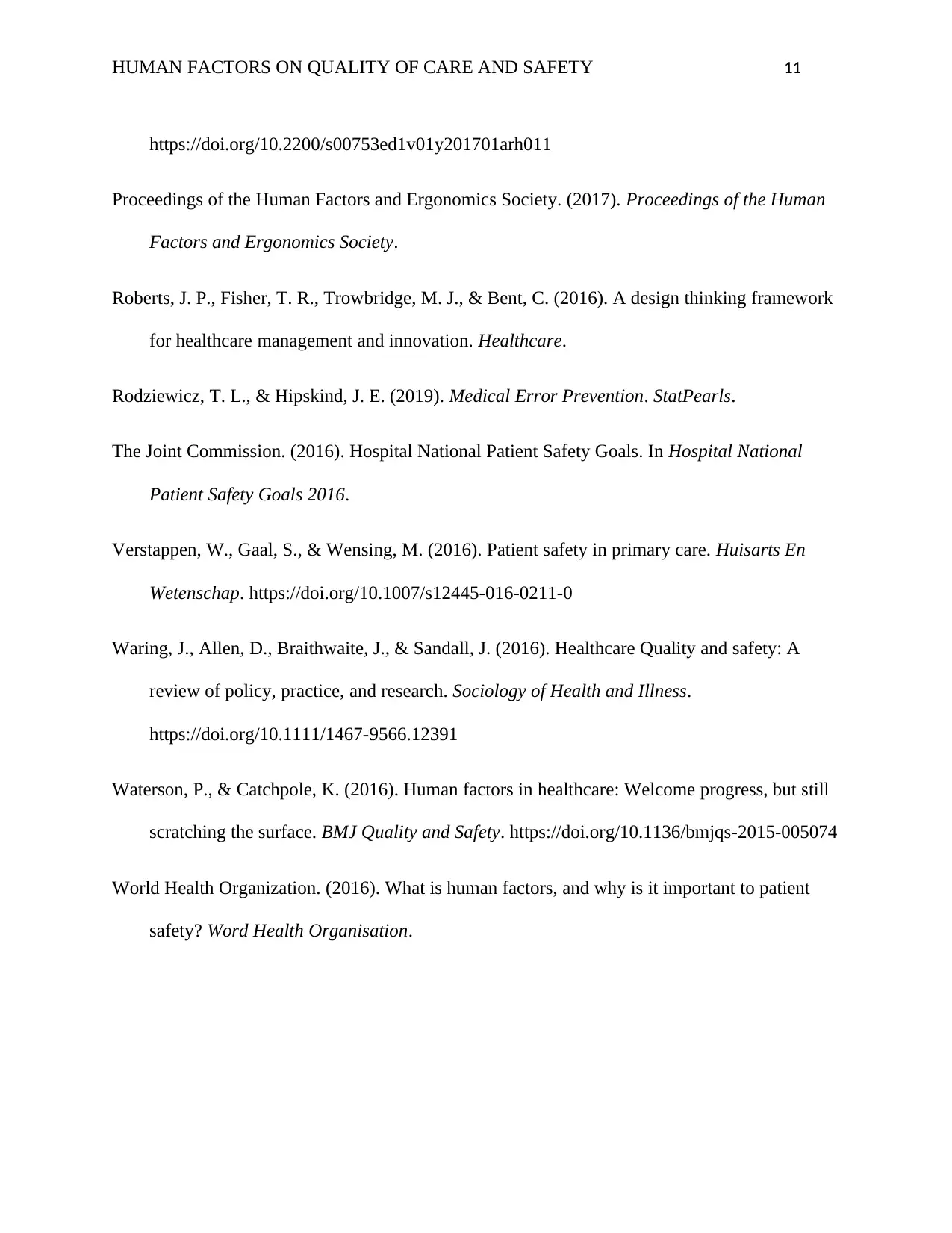
HUMAN FACTORS ON QUALITY OF CARE AND SAFETY 11
https://doi.org/10.2200/s00753ed1v01y201701arh011
Proceedings of the Human Factors and Ergonomics Society. (2017). Proceedings of the Human
Factors and Ergonomics Society.
Roberts, J. P., Fisher, T. R., Trowbridge, M. J., & Bent, C. (2016). A design thinking framework
for healthcare management and innovation. Healthcare.
Rodziewicz, T. L., & Hipskind, J. E. (2019). Medical Error Prevention. StatPearls.
The Joint Commission. (2016). Hospital National Patient Safety Goals. In Hospital National
Patient Safety Goals 2016.
Verstappen, W., Gaal, S., & Wensing, M. (2016). Patient safety in primary care. Huisarts En
Wetenschap. https://doi.org/10.1007/s12445-016-0211-0
Waring, J., Allen, D., Braithwaite, J., & Sandall, J. (2016). Healthcare Quality and safety: A
review of policy, practice, and research. Sociology of Health and Illness.
https://doi.org/10.1111/1467-9566.12391
Waterson, P., & Catchpole, K. (2016). Human factors in healthcare: Welcome progress, but still
scratching the surface. BMJ Quality and Safety. https://doi.org/10.1136/bmjqs-2015-005074
World Health Organization. (2016). What is human factors, and why is it important to patient
safety? Word Health Organisation.
https://doi.org/10.2200/s00753ed1v01y201701arh011
Proceedings of the Human Factors and Ergonomics Society. (2017). Proceedings of the Human
Factors and Ergonomics Society.
Roberts, J. P., Fisher, T. R., Trowbridge, M. J., & Bent, C. (2016). A design thinking framework
for healthcare management and innovation. Healthcare.
Rodziewicz, T. L., & Hipskind, J. E. (2019). Medical Error Prevention. StatPearls.
The Joint Commission. (2016). Hospital National Patient Safety Goals. In Hospital National
Patient Safety Goals 2016.
Verstappen, W., Gaal, S., & Wensing, M. (2016). Patient safety in primary care. Huisarts En
Wetenschap. https://doi.org/10.1007/s12445-016-0211-0
Waring, J., Allen, D., Braithwaite, J., & Sandall, J. (2016). Healthcare Quality and safety: A
review of policy, practice, and research. Sociology of Health and Illness.
https://doi.org/10.1111/1467-9566.12391
Waterson, P., & Catchpole, K. (2016). Human factors in healthcare: Welcome progress, but still
scratching the surface. BMJ Quality and Safety. https://doi.org/10.1136/bmjqs-2015-005074
World Health Organization. (2016). What is human factors, and why is it important to patient
safety? Word Health Organisation.
1 out of 11
Related Documents
Your All-in-One AI-Powered Toolkit for Academic Success.
+13062052269
info@desklib.com
Available 24*7 on WhatsApp / Email
![[object Object]](/_next/static/media/star-bottom.7253800d.svg)
Unlock your academic potential
Copyright © 2020–2025 A2Z Services. All Rights Reserved. Developed and managed by ZUCOL.





